Cucumbers are delicious, refreshing, and packed with nutrients. However, their susceptibility to fungal diseases can be a nightmare for gardeners. If left untreated, these diseases can cause significant damage to your Cucumber plants and even lead to total crop loss. Identifying and treating Cucumber fungal diseases is crucial to ensure the health of your plants and a bountiful harvest. By understanding the different types of fungal infections that can affect Cucumbers and their symptoms, you must take proactive measures to prevent them from occurring.
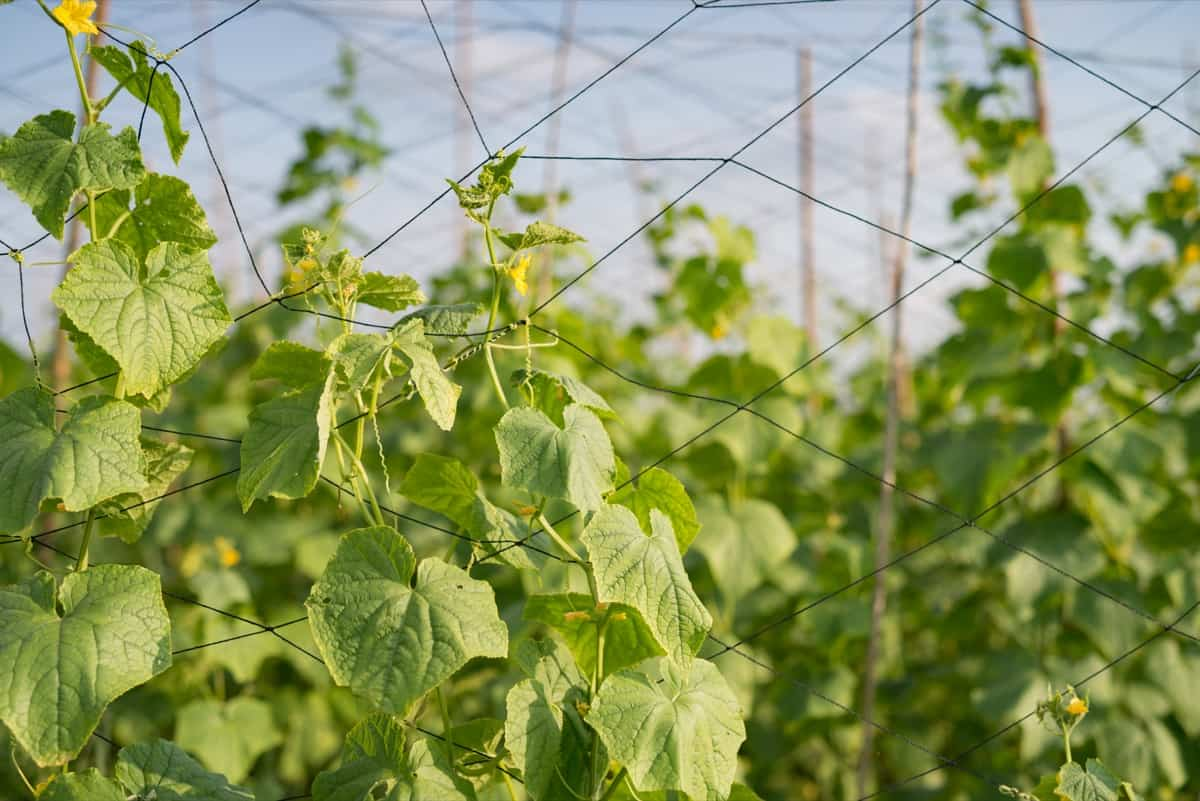
How to Identify and Treat Cucumber Fungal Diseases
Common Fungal Diseases in Cucumbers: Identification and Treatment
Cucumbers are prone to fungal diseases that significantly reduce their yield and quality. Identifying these diseases early on prevents them from spreading and causing further damage. Some of the most common Cucumber fungal diseases include powdery mildew, downy mildew, anthracnose, leaf spot, botrytis, scab, and Fusarium wilt. Powdery mildew is easily identifiable by the white powder-like substance on leaves.
Downy mildew causes yellow spots on the top side of leaves with a greyish mold underneath. Anthracnose causes brown or black lesions on leaves and fruit, while leaf spot has small circular brown spots with yellow halos. Botrytis affects flowers and fruits, causing gray mold to appear, while Cucumber scab produces rough patches or dark green scars on Cucumbers’ skin. Fusarium wilt results in wilting plants leading to death eventually.
Treating these fungal infections effectively requires identifying them accurately and using targeted remedies such as fungicides or organic solutions like baking soda spray for powdery mildew. Applying copper-based fungicides is effective against downy mildew, while removing infected parts helps prevent further spread of anthracnose.
Fighting off Cucumber diseases may require multiple strategies, such as managing moisture levels through proper irrigation or regularly rotating crops to limit soil pathogen buildup. Effective pest management techniques like scouting regularly for pests also help control plant stress, making it less vulnerable to attack from pathogens, ultimately keeping your crop healthy throughout its growth cycle.
Effective Remedies for Cucumber Fungal Infections
Cucumbers are a great addition to any garden but are also prone to fungal infections. Luckily, several remedies can help prevent and treat these diseases. One of the most effective ways to prevent Cucumber fungal infections is by practicing good garden hygiene. This includes removing infected plant debris, rotating crops yearly, and avoiding overhead watering, which can spread disease. Another remedy is using natural fungicides such as baking soda or neem oil.
In case you missed it: Stages of Cucumber Plant Growth
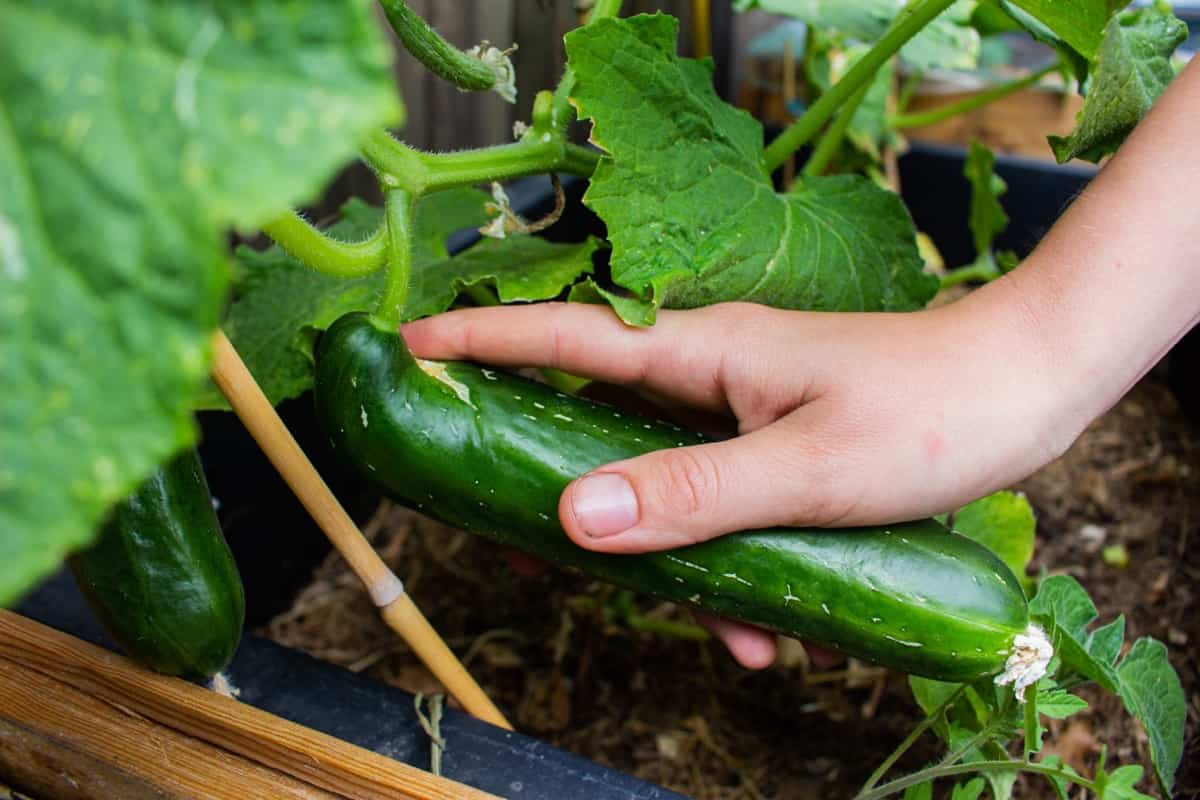
Baking soda mixed with water can be sprayed directly on the leaves of affected plants to neutralize fungal spores. At the same time, neem oil is a preventative measure and control method for many common Cucumber fungal diseases. In addition, introducing beneficial insects like ladybugs or lacewings into your garden can help control pests that may transmit harmful fungi. Selecting resistant varieties is another way to reduce the impact of Cucumber fungal diseases in your garden.
Identifying and Managing Cucumber Downy Mildew
Cucumber downy mildew is a fungal disease that can damage Cucumber plants and reduce their yield. Identifying the early signs of Cucumber downy mildew is crucial for managing this fungal infection effectively. The first sign of this disease is yellowing patches on the upper surface of leaves, which eventually turn brown or gray as the fungus grows. As the infection progresses, you may also notice white mold growth on the undersides of the leaves.
Managing Cucumber downy mildew requires taking preventive measures such as planting resistant varieties or using fungicides labeled for control against this particular fungus. You should also practice good hygiene by removing infected plant debris and avoiding overhead watering. Use copper-based fungicides or biological products if your plants are infected with Cucumber downy mildew. It’s important to start treatment as soon as possible before the infection spreads throughout your garden.
Preventing and Treating Cucumber Powdery Mildew
Cucumber powdery mildew is a common fungal disease affecting Cucumbers and other squash family members. It causes white or grayish spots on the leaves, stems, fruits, and flowers of plants. If left untreated, it can damage the plant’s ability to produce fruit. Choose resistant varieties of Cucumber seeds less susceptible to this fungus to prevent Cucumber powdery mildew from infecting your crops. Make sure you space your plants properly so they have good air circulation, and keep them well-watered at all times.
If you observe any signs of powdery mildew on your Cucumbers, act quickly to treat them before the infection spreads. One effective remedy is spraying a solution with baking soda and water onto affected areas once a week until symptoms disappear. Another option is applying neem oil or sulfur-based fungicides to infected plants as soon as possible after detection for maximum effectiveness in preventing further spread.
Removing infected plant parts immediately – prune off severely affected leaves and discard them far away from healthy plants- is important to not create favorable conditions for spore’s growth during hot days when high humidity levels are high. Prevention is key when dealing with Cucumber powdery mildew – planting resistant varieties along with proper spacing will go a long way towards reducing the risk of infection, while early treatment using natural remedies like baking soda solutions or chemical controls such as neem oil will help stop its spread if detected early enough.
In case you missed it: How to Prevent Bitter Cucumbers and Grow Sweet and Juicy Fruits
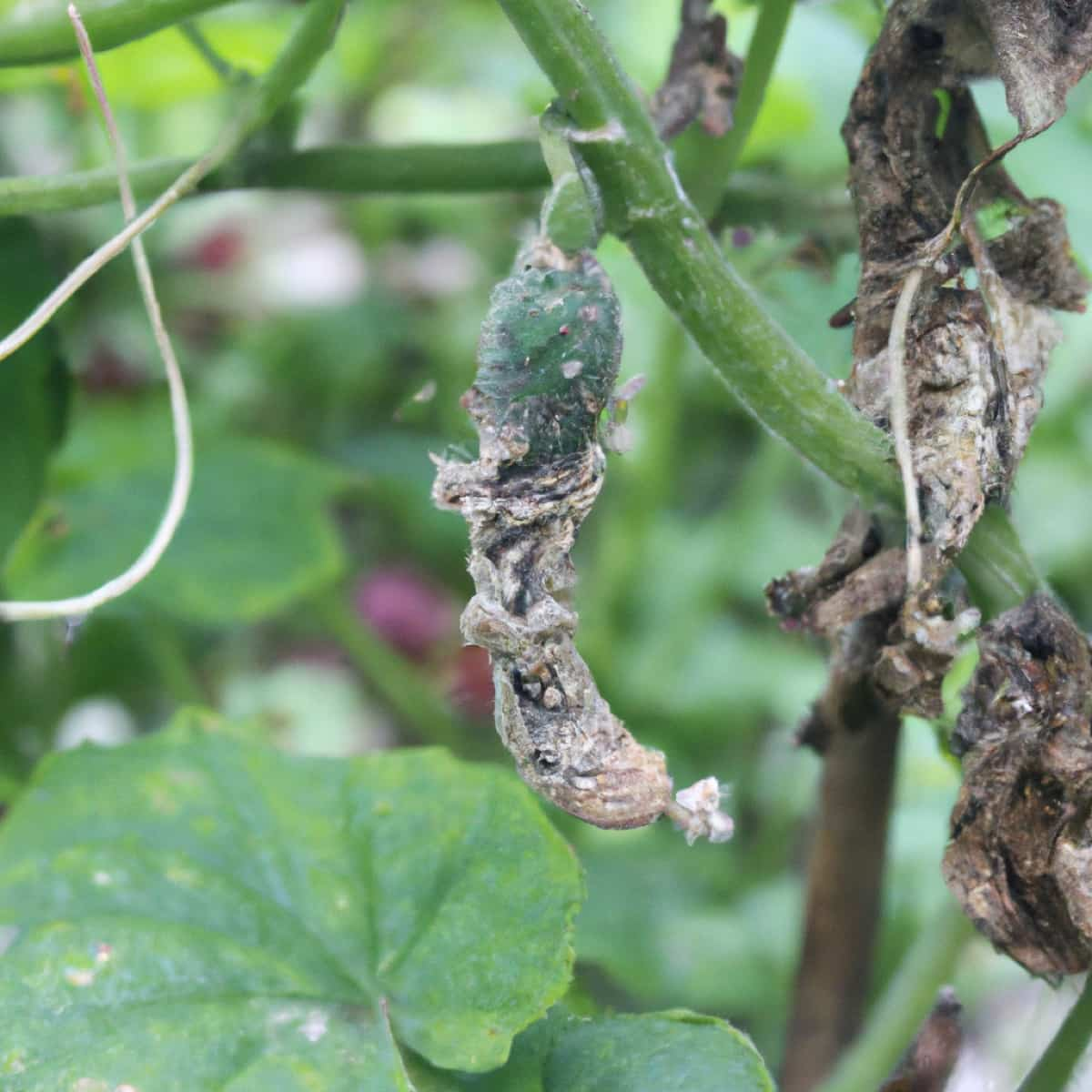
Diagnosing and Curing Cucumber Anthracnose
Cucumber anthracnose is a fungal disease that affects Cucumbers, causing damage to the fruit and foliage. The disease appears as dark, sunken lesions on the Cucumber leaves, stems, and fruit. One of the most effective ways to diagnose this disease is by visually inspecting plant tissues. If you notice dark spots or discolorations on your Cucumber plants’ leaves, stems, or fruits, they have likely been infected with anthracnose.
To cure Cucumber anthracnose effectively, it’s best to start with preventative measures such as crop rotation and avoiding overhead watering, which can increase plant humidity levels, leading to infections. Another treatment option for managing this fungal disease includes applying fungicides when necessary early enough before severe leaf spot development occurs.
Organic treatments like copper-based fungicides or bio fungicides can also help prevent the further spread of anthracnose infection. Diagnosing and curing Cucumber anthracnose requires careful observation and prompt action. Proper management practices, including good sanitation techniques like removing infected plant parts immediately, plus suitable chemical applications if needed, will ensure healthy harvests from your Cucumbers year after year.
Managing Cucumber Leaf Spot: Identification and Treatment
Cucumber leaf spot is a fungal disease often occurring during warm and humid weather. It can cause significant damage to Cucumber plants by causing yellowing, wilting, and defoliating the leaves. Therefore, gardeners and farmers must learn how to identify and manage this fungal infection. To correctly diagnose Cucumber leaf spot, look out for small brown or black spots with a yellow halo on the upper side of the leaves.
The fungus may also produce white spores in circular patterns on the underside of infected leaves. Once identified, managing the Cucumber leaf spot involves removing all infected plant parts as soon as possible to avoid further spread. Dispose of these affected parts away from other growing Cucumbers carefully. Additionally, applying copper-based fungicides or sulfur sprays regularly can help prevent further infections.
In case you missed it: How to Build a Trellis for Cucumbers: A Step-by-Step Planting Guide for Beginners
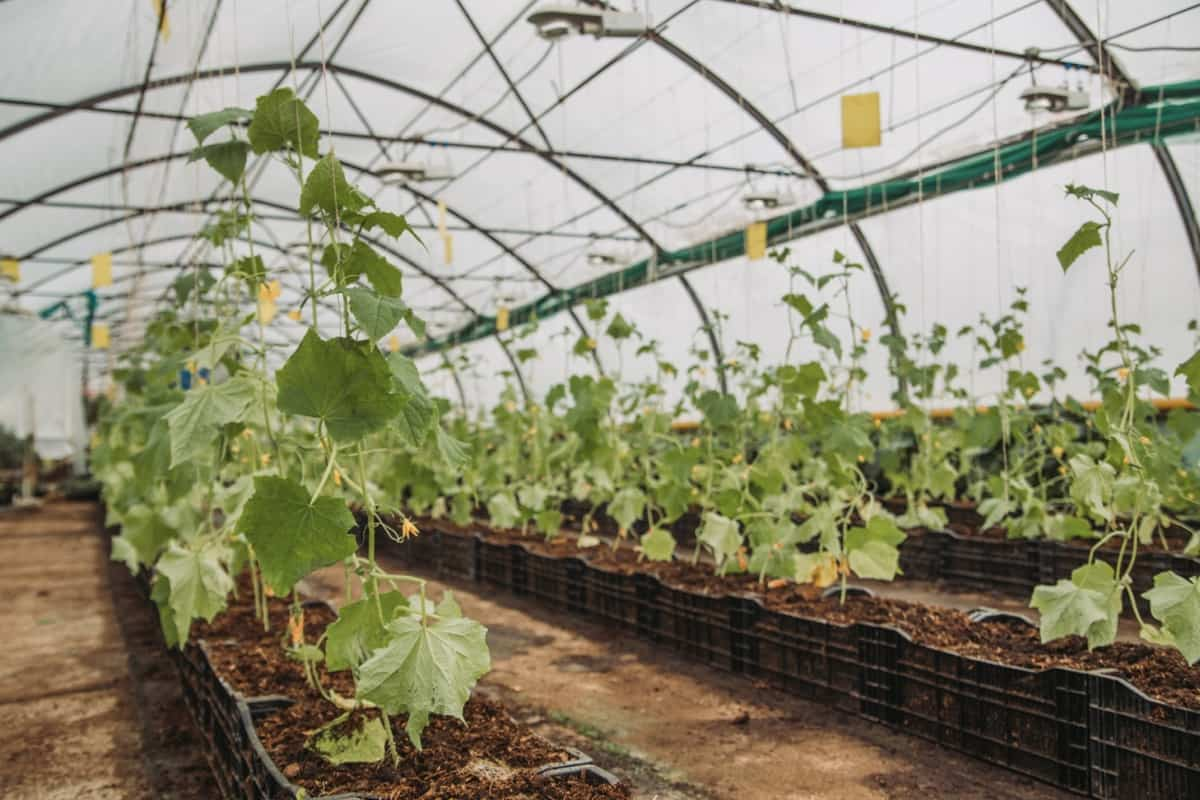
Ensure you follow manufacturer recommendations when using chemical control methods. Early detection is crucial in effectively managing plant diseases such as Cucumber leaf spot. Taking preventive measures like keeping your plants healthy through proper nutrition and sanitation practices while monitoring them frequently will ensure you avoid crop loss due to this common fungal disease.
Fighting Cucumber Botrytis with Effective Strategies
Cucumber Botrytis is a fungal disease that affects Cucumbers during the growing season. It causes serious damage to the plant, leading to reduced yield and quality of fruits. However, it is possible to fight this disease and prevent its spread with effective strategies. One strategy for fighting Cucumber botrytis is properly managing humidity levels in the greenhouse or field. This means ensuring adequate ventilation and avoiding over-watering plants, as excessive moisture can create favorable conditions for fungal growth.
Another strategy involves regularly scouting and removing infected plant parts such as leaves, stems, or fruits. This prevents the disease from spreading within the crop and reduces inoculums levels from which new infections could arise. As a preventive measure, growers may also use fungicides specifically labeled for controlling botrytis on Cucumber crops. These should be applied according to manufacturer instructions at recommended intervals throughout the growing season.
Crop rotation can also help manage Cucumber botrytis by reducing opportunities for residual inoculums buildup in soil or debris left after harvesting infected plants from previous seasons. Fighting Cucumber botrytis requires an integrated approach that includes proper environmental management practices such as ventilation control and sanitation measures like regularly removing diseased plant material and fungicide applications when necessary. By implementing these strategies, growers can successfully manage their crops while minimizing losses caused by this fungal pathogen.
Cucumber Scab: Recognizing and Treating the Fungal Disease
Cucumber scab is a fungal disease that can cause significant damage to Cucumber plants if not identified and treated promptly. This disease affects leaves and fruits, causing them to develop small, sunken lesions that eventually become corky or scabby. The main culprit behind the Cucumber scab is the fungus. It thrives in warm, humid conditions and spreads through water splash or contact with infected plant debris.
In case you missed it: Growing Cucumber from Seed to Harvest: A Detailed Guide for Beginners
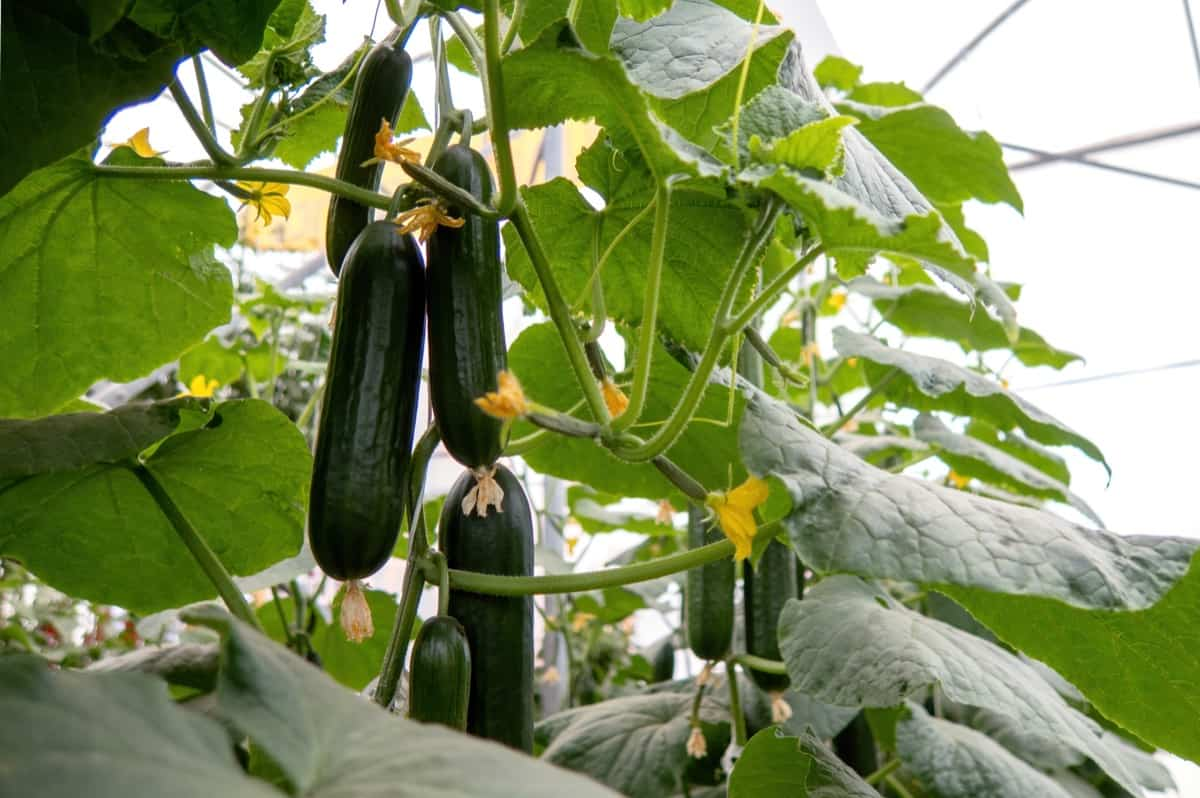
To recognize this disease early on, look for light brown spots on the leaves that gradually expand into larger lesions as they mature. On fruits, you’ll notice raised bumps or rough patches that affect their appearance and marketability. Practicing good cultural control measures such as keeping your garden clean of debris and avoiding overhead watering is essential to treat Cucumber scab effectively.
Fungicides can also be used preventively before symptoms appear or curatively after the infection. Recognizing and treating Cucumber scab early on can save you from substantial crop loss due to fruit blemishes caused by this fungal disease. You can successfully manage this problem in your garden or farm by implementing proper cultural practices alongside fungicide applications when necessary.
Controlling Cucumber Fusarium Wilt: Diagnosis and Solutions
Cucumber plants affected by Fusarium wilt can quickly become stunted, discolored, and even die off. Diagnosing this disease can be difficult since it shares symptoms with other Cucumber diseases like root rot or bacterial wilt. However, one telltale sign of Fusarium wilt is that infected plants will exhibit yellowing leaves that begin at the base of the stem and gradually move up to the top.
To control this disease effectively, it’s essential to avoid planting susceptible varieties in contaminated soils since these varieties are more likely to get infected than others. Crop rotation also helps break down fungi in previous crops while providing a clean slate for new healthy seedlings.
Fungicides are another way to manage Cucumber fusarium wilt infections; however, they should only be used as last resort after all preventive measures have been exhausted. Monitoring your Cucumber plants’ health regularly is crucial and acting fast if you suspect any infection from this destructive fungus.
In case you missed it: Best Season to Grow Cucumber at Home in India: In Pots, Terrace, Apartment Balcony, and Backyards
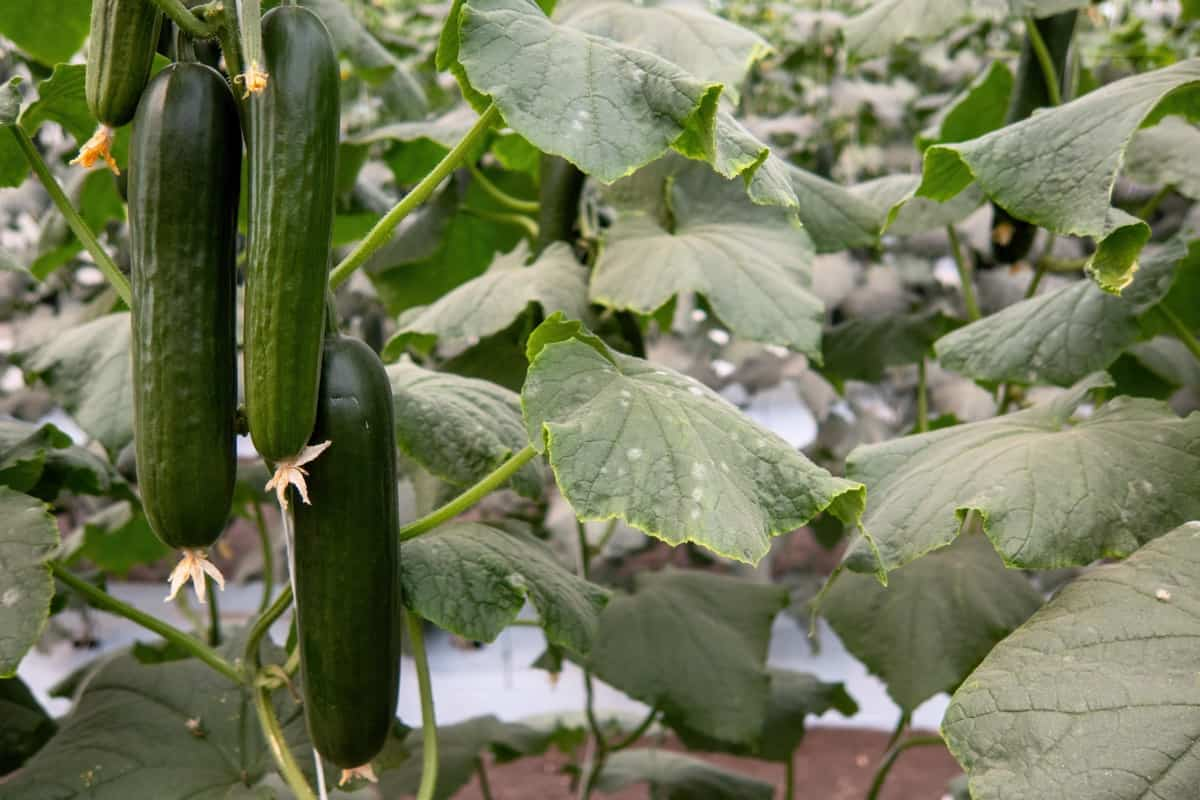
Conclusion
Identifying and treating Cucumber fungal diseases is crucial to ensure the health of your plants and a bountiful harvest. By understanding the different types of fungal infections that can affect Cucumbers and their symptoms, you must take proactive measures to prevent them from occurring. Remember to maintain proper plant hygiene, avoid overwatering or overcrowding your plants, and provide adequate air circulation and sunlight exposure while monitoring for early signs of disease.
It’s also important to choose resistant varieties when possible and use organic fungicides as necessary. By following these tips on identifying, treating, preventing, and managing Cucumber fungal diseases, you’ll be well on your way to growing healthy and fruitful Cucumbers in your garden year after year.
- Where to Place Indoor Plants in Your Home
- How to Grow Tomatoes Organically at Home: A Comprehensive Guide
- Organic Gardening on a Budget: Low-Cost Methods and Materials
- Gongura Seed Germination and Planting Methods
- Cabbage Seed Germination and Selection
- Broccoli Seed Germination and Selection
- Asparagus Seed Germination and Variety Selection
- Seasonal Flower Gardening: Best Practices for Spring, Summer, Fall, and Winter
- How to Grow Hibiscus from Flower
- Plantation Ideas for Home Decoration: A Beginners Guide
- Flower Garden Designs and Layouts for Beginners
- Planting and Spacing Techniques in Papaya: A Beginner’s Guide
- Growing Gold: Essential Techniques for Planting Pineapples
- How to Make Kalanchoe Plant Bushy: Home Remedies and Solutions
- 11 Reasons Why Your Gardenia is Not Blooming: Home Remedies and Solutions
- Eco Elegance: The Guide to Designing a Drought-Tolerant Landscape
- Gardening on a Slope: Strategies for Hillside Landscaping
- Nourish and Flourish: Top Organic Mulches for Thriving House Plants
- Everything You Want to Know about Indian Mogra Flower: Discover Uses and Growing
- Green Thumb Success: Expert Tips for Cultivating Greenhouse Pumpkins All Year Round
- Maximize Growth & Flavor: The Ultimate Guide to Companion Planting in Herb Gardens
- How to Control Rhododendron Problems Naturally: Home Remedies and Organic Ways to Fix Them
- Natural Magic: The Remarkable Benefits of Cinnamon for Plants
- Best Steps to Revive Dying Tulip with Natural and Organic Treatment
- 10 Reasons Why Your Angel Trumpet is Not Blooming: Remedies and Treatment
- How to Fix Periwinkle Leaf and Flower-Related Problems: Natural Remedies and Solutions
- How to Fix Zinnias Leaf and Flower Problems: Discover Natural and Home Remedies
- Organic Steps to Induce Lemon Tree Flowers: A Comprehensive Guide
- Bloom Booster: Crafting the Perfect Homemade Bougainvillea Fertilizer
- Optimizing Growth: A Guide to Applying NPK Fertilizer for Potted Plants
- 10 Best Homemade Fertilizers for Rubber Plant: DIY Recipes and Application Method
- How to Boost Female Pumpkin Flowers: Effective Steps for More Flowers and High Yields
- Transform Your Indoor Garden: Top Benefits of Pink Salt for Houseplants
- 10 Best Homemade Fertilizers for Peacock Plants (Calathea): Easy DIY Guide
- Unlock Blooms: 9 Reasons Why Your Potted Chrysanthemum is Not Blooming
- 8 Reasons Why Your Potted Hibiscus is Not Blooming: Fix it with Simple Solutions
- Unlock Blooms: 9 Key Reasons Your Potted Frangipani Won’t Flower
- 10 Reasons Why Is My Ice Plant Not Blooming: Remedies and Treatment
- 10 Reasons Why My Potted Hydrangea Not Blooming: Treatment and Remedies
- 10 Reasons Why is My Wisteria Not Blooming: Remedies and Treatment
- 10 Reasons Why is My Goldfish Plant Not Blooming: Remedies and Treatment
- Maximize Your Space: Ultimate Guide to Balcony Gardening with Grow Bags
- 10 Reasons Why Your Iris is Not Blooming: Remedies and Treatment
- 10 Reasons Why Your Anthurium Plant is Not Blooming: Treatment and Remedies
- 10 Reasons Why Your Aquaponic Plants Are Not Flowering: Remedies and Treatment
- 10 Reasons Why Your Agapanthus is Not Flowering: Remedies and Treatment
- Ultimate Guide to Brown Turkey Fig: Steps to Growing Brown Turkey Figs
- How to Grow Acai Berry: Propagation, Planting, and Care
- Ultimate Guide to Growing Satsuma Plum: Exploring Planting, Pruning and Care
- 10 Reasons Why Your Plant Buds are Falling off: Prevention and Remedies
- Nourish to Flourish: The Best NPK Ratio for Houseplants
- Ultimate Guide to Mexican Bird of Paradise: Explore from Propagation to Planting and Care
- Ultimate Guide to Devils Backbone Plant: Explore from Propagation to Planting and Care
- Ultimate Guide to Troubleshooting Seed Starting Problems
- 10 Reasons Why Your Flower Plant is Not Blooming: Remedies and Treatment
- Natural Fertilizer Recipes for Flowers: Discover from Banana Peel to Epsom Salt
- Homemade Fertilizers for Malabar Spinach: Get More and Large Green Leaves
- Natural Fertilizer Recipes for Vegetables: Discover from Composting to Application
- How to Grow Tulsi in Home Garden: Discover from Propagation to Planting
- Unlocking Success: A Complete Manual for Growing Azaleas in Pots
- Winter Pruning Guide: Learn About Cutting Back Plants in Dormant Season
- Ultimate Guide to Orchid Aerial Roots Care: Tips for Healthy Growth and Maintenance
- Homemade Fertilizers for Squash: DIY Organic Fertilizers Recipe
- Homemade Fertilizers for Asparagus: DIY Organic Fertilizers
- Homemade Fertilizers for Zucchini: DIY Organic Fertilizers Recipe
- Homemade Fertilizers for Rosemary: A Guide to DIY Organic Fertilizers
- Homemade Fertilizers for Peas: DIY Organic Fertilizers for Pea Plants
- Ultimate Guide to Using Epsom Salt for Potted Plants: Tips, Dosage, and Benefits
- Expert Guide on How to Transplant Cucumber Seedlings for Maximum Harvest
- Effective Fertilizer Management of Arecanut: A Comprehensive Guide
- The Ultimate Guide to Growing Kagzi Lemons in Home Gardens
- How to Grow Nectarine from Seed: A Comprehensive Guide for Beginners
- Watermelon Fertilizer Schedule: Fertilization Based on Growth Stages
- Ultimate Guide to Growing Aronia Berries: Tips, Tricks, and Best Practices
- Effective Strategies for Managing Mango Flowers to Boost Yields
- Italian Plum Trees: A Comprehensive Guide for Varieties, Planting and Care
- How to Prune a Weeping Mulberry Tree: A Comprehensive Guide for Beginners
- How to Grow Boysenberries in a Pot: A Comprehensive Guide for Beginners
- Step-by-Step Guide to Building a Tower Garden in Switzerland
- How to Grow Pittosporum from Cuttings: Steps for Successful Cutting Propagation
- The Rise of Tower Gardening in Austria: Elevating Urban Green Spaces with Vertical Farming
- The Rise of Tower Gardening in Africa: Elevating Urban Green Spaces with Vertical Farming
- Best Fertilizer for Coconut Trees: Application Guidelines for Coconut Palm
- Nutrient Management for Tower Gardens: How to Mix Your Nutrients for Tower Farms
- Vertical Tower Farming in Portugal: Sustainable Agriculture in Portugal Urban Areas
- Vertical Farming with Tower Farms in Italy
- Top 10 Steps to Growing Kentia Palm: How to Plant and Care Guide
- Tips That Will Make You Utilize Your Garden More Often
- How to Grow Cauliflower in Aeroponic Towers
- How to Grow Leeks on Tower Gardens: Step-By-Step Guide for Beginners
- Growing Carolina Reaper Chili Peppers on a Tower Garden Vertically
- How to Propagate Weeping Fig (Ficus Benjamina): In Water, Cutting, Soil, Air, and Rooting Hormone
- How to Propagate Monstera in Water
- Steps to Growing Onions in Aquaponics: Explore from How to Plant to Harvest
- How to Propagate Philodendron: With Water, Soil, Air, and Division
- How to Propagate Calathea Plant: Ways to Grow from Water, Soil, Division, and Cuttings
- How to Propagate Rubber Plant: Ways to Grow Ficus Elastica from Water, Soil, and Cuttings
- How to Increase Watermelon Fruit Size: Management for Getting Bigger Watermelons
- How to Increase Apple Fruit Size: Management for Getting Bigger Apple Fruits in Your Orchard
- Best Fertilizer for Black Pepper Plants: Nutrient Management in Black Pepper/Piper Nigrum Farms